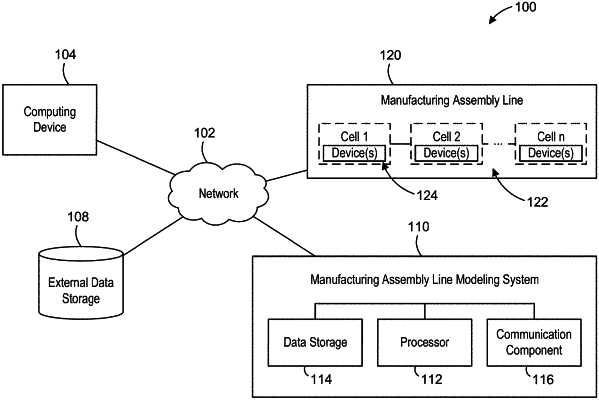| CPC G06N 5/04 (2013.01) [G01M 99/005 (2013.01); G05B 19/4183 (2013.01); G05B 19/41805 (2013.01); G05B 19/41865 (2013.01); G05B 19/41885 (2013.01); G05B 23/0267 (2013.01); G06N 5/01 (2023.01); G06N 20/00 (2019.01); G05B 2219/32194 (2013.01)] | 20 Claims |

|
1. A method for assessing faults in a manufacturing assembly line, the manufacturing assembly line comprising a plurality of cells, each cell being configured to successively process a workpiece along the manufacturing assembly line, the method comprising operating a processor to:
receive cell data associated with at least one cell of the manufacturing assembly line, the cell data comprising, for each cell, at least one input state of that cell and a cell position of that cell within the manufacturing assembly line;
extract feature data from the cell data, the feature data comprising at least one input state and at least one a cell position of at least one cell;
determine a plurality of faults, each fault corresponding to one cell;
determine whether at least one fault of the plurality of faults comprises a defective workpiece fault;
for each defective workpiece fault,
generate a scrap workpiece cost associated with the defective workpiece fault;
determine whether the defective workpiece fault can be remedied with a cell within the plurality of cells configurable as a rework cell for remedying manufacturing faults; and
in response to determining the defective workpiece fault can be remedied with a rework cell, generate a rework workpiece cost associated with the defective workpiece fault;
apply the extracted feature data, the scrap workpiece cost, and the rework workpiece cost to a predictive model generated for predicting a production level of the manufacturing assembly line to determine a priority level for each fault and a recommendation for each defective workpiece fault, the recommendation comprising one of a rework recommendation to use the rework cell for remedying the defective workpiece fault and a scrap recommendation to discard the defective workpiece;
determine at least one high priority fault from the plurality of faults based on the priority level for each fault;
determine whether the at least one high priority fault comprises a defective workpiece fault; and
in response to determining that the at least one high priority fault comprises a defective workpiece fault, generate at least one operator alert based on the at least one high priority fault and the recommendation for the defective workpiece fault;
otherwise, generate at least one operator alert based on the at least one high priority fault.
|